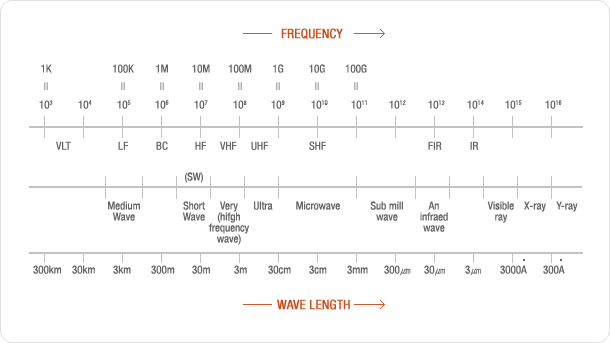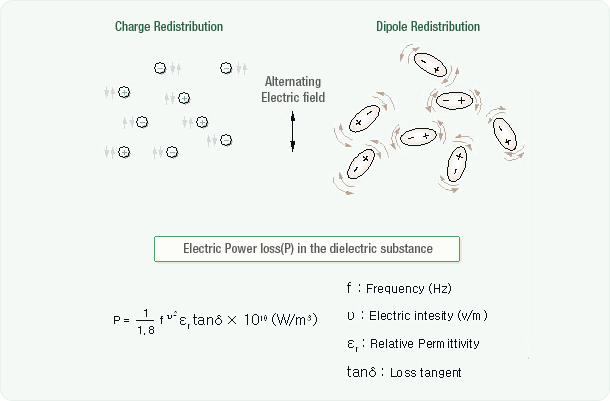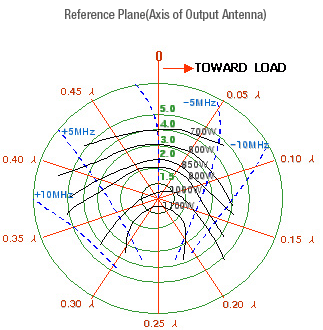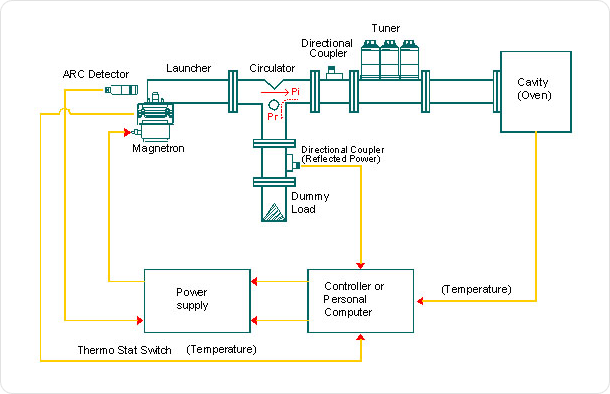| |
| 1. Dielectric Heating Termiology |
| Electronic heating or radio frequency
heating may be classified as induction, capacitive or
"macrowave," and microwave. |
| |
| 1-1. Induction Heating |
As
the name implies, induction heating produces heat
in a conductor by inducing eddy currents in a
manner similar to that of a transformer when a
current in the secondary windings is produced
by induction from a current inthe primary windings.
These currents supply the heat required due to
resistance heating (I2R)losses.
One of the main advantages of induction heating
is that the heating is that the heating can be
confined to that part of the work pieceor material
whih is directly opposite the coil inducing the
current.
|
|
| Induction
Heating |
|
| |
|
| |
| 1-2. Capacitive Heating |
Capacitive
heating involves the heating of poor electrical
conductors through dipole polarization at frequencies
between 1 and 300 MHz.
Although the phenomenon of dipole losses had been
known for a long time, its application as a means
of heating dates back only to just before 1940.
Capacitive heating is often referred to as dielcetric
heating because it is the heating of a dielectric
or nonconductor. |
Low-Frequency capacitive
heating |
In
practice the heating usually takes place between
parallel plates such as in a capacitor or condenser.
Indeed, the term dielectric loss comes from the
fact that in a capacitor some of the current is
lost as heat.
The term microwave heating is sometimes used,
referring to the much longer wavelengths of the
capacitive heating range compared to the microwave
range. |
|
| |
|
| |
| 1-3. Microwave Heating |
Microwave
heating is also dielectric heating but refers
to the heating that takes place in a nonconductor
due to polarization effects at frequencies between
300 MHz and 300 GHz (wavelengths between 1 m and
1 mm).
Thus, the basic differences between capacitive
and microwave heating are related first to the
frequencies employed and second to the manner
in which heating is carried out (in capacitive
heating the material is usually placed between
electrodes, whereas in microwave heating a closed
cavity or oven often is used. |
|
| Microwave
Heating |
|
 |
| |
|
| |
| 2. Dielectric
Heating |
The interaction
of an electric field with a dielectric has its origin
in the response of charge particled to the applied field.
The displacement of these charge particles from their
equilibrium positions gives rise to induced dipoles
which respond to the applied field. Such induced polarisation
arises mainly from the displacement of electrons around
the nuclei (electronic polarisation) or due to the relative
displacement of atomic nuclei because of the unequal
distribution of charge in molecule formation (atomic
polarisation).
In addition to induced dipoles some dielectrics, known
as polar dielectrics, contain permanent dipoles due
to the assymmetric charge distribution of unlike charge
partners in a molecule which tend to reorientate under
the influence of a changing electric field, thus giving
rise to orientation polarisation.
Finally, another source of polarisation arises from
charge build-up in interfaces between components in
heterogeneous systems, termed interfacial, space charge
or Maxwell-Wagner polarisation.Figure shows a schematic
representation of Maxwell-Wagner and orientation polarisation
due to an alternating electric field.
These two mechanisms, together with
d.c. conductivity, are the basis of high frequency heating. |
 |
| |
|
| |
| 3. Allocated Frequency |
| Microwave are
electromagnetic energy. Microwave energy is a nonioizing
radiation that causes molecular motion by migration
of ions and rotation of dipoles, but does not cause
changes in molecular structure.
Microwave energy has a frequency range from 300 to 300,000
MHz. Four frequencies are used for industrial and scientific
microwave heating and drying. These frequencies were
established for industrial, scientific, and medical
use by the federal communications comission and conform
to the international radio regulations adopted at Geneva
in 1959. Of these frequencies, 2450 MHz is the most
commonly used and is the frequency used in all home
microwave units.
1. 915 ± 25 MHz
2. 2450 ± 50 MHz
3. 5800 ± 75 MHz
4. 24125 ± 125 MHz |
| |
|
| |
| 4. The properties
of a microwave heating |
- We don't heat conduction and can
heat dielectric substances in short time.
- Heating efficiency is good and we can save energy more
than normal heating method.
- We can heat complex shaped material from inside of it.
- We can heat with packing case.
- We can dry the moisture uniformly.
- It is simple to control the heating temperature.
- The adaption of sensor (temperature, moisture etc.)and
automation are very simple.
- Seal up heating is possible and it is easy to optional
mood or vacuum condition for heating.
- Environments (no noise, hot air, exhausted gas...) are
good.
- It is easy to control. |
| |
|
| |
| 5. Microwave
Penetration Depth |
The attenuation
factor determines the absorption of energy within the
dielectric as a function of depth from the surface of
the dielectric, as a function of depth from the surface
of the dielectric, as described by Lambert's law (Pz
= Poe -2∝z) and is inversely related to the materials
penetration depth, that is, the depth from the surface
at which 1/e of the power at the surface is not attenuated
or absorbed. |
Substance
|
Temperature |
915MHz
|
2450 MHz |
| ½ Penetration |
εr |
tan δ |
½ Penetration |
εr |
tan δ |
| ICE |
-12 |
1600 |
|
|
|
|
|
| Water |
25 |
9.0 |
|
|
|
|
|
| Water |
55 |
16.0 |
|
300×10-4 |
|
|
|
| Water |
85 |
24.0 |
|
|
|
|
|
| Beef |
4.5 |
1.7 |
|
700×10-4 |
|
|
|
| Polyethylene |
|
|
|
2×10-4 |
|
|
|
| Teflon |
|
|
|
2×10-4 |
|
|
|
| Nylon |
|
|
|
|
|
|
|
| Paper |
|
|
2.7 |
600×10-4
|
|
|
|
| Glass |
|
|
5.1 |
100×10-4 |
|
|
|
| Ceramics |
|
|
5.6 |
145×10-4 |
|
|
|
|
 |
| |
|
| |
| 6. The experiences
of microwave heating |
| |
|
| Using to food |
|
Using to grain |
|
 Foaming
(snack...) Foaming
(snack...)
 Dry
(vegetable, onion, meat......) Dry
(vegetable, onion, meat......)
 Heat
cooking (fish cake, bacon, re-heaing of food...) Heat
cooking (fish cake, bacon, re-heaing of food...)
 Defrost
(fish, meat...) Defrost
(fish, meat...)
 Bread
aging Bread
aging |
|
 insecticide insecticide
 Dry
(wheat, paddy...) Dry
(wheat, paddy...) |
|
| Using to rubber industry |
|
Dry of wood, stick , bending
working |
|
 Rubber
vulcanization Rubber
vulcanization
 Foaming Foaming |
|
|
|
| Using to medical
care |
|
Melting |
|
 Care
of cancer Care
of cancer |
|
|
|
| Making paper,
dyeing of febric and dry |
|
Leather dry |
|
|
|
| |
|
| |
| 7. Point of
microwave application |
| |
 |
Operating Conditions
:
Power Supply : Single Phase
Full-Wave Rectifier Without Filter,
Average Anode Current : 350mA
Wave
Guide : Standard Launcher
─ Output Power(W)
...... Frequency(MHz) |
|
| |
| Load Impedance Matching Technique (Maximum Efficiency) |
ⓐ Optimum design of Cavity and Wave
Guide
ⓑ Impedance measurement and analysis (Network Analyzer,
User Calibration Kit, Antenna Probe)
ⓒ Tuner adaption
ⓓ Simulation Program pre-analysis |
| |
|
| |
| Leakage shield Technique |
ⓐ Shielding Gasket
ⓑ λg/4 Choke, Choke Coil
ⓒ Microwave Absorbent |
| |
|
| |
| Uniform heating Technique |
ⓐ 3-Stub Tuner, Stirrer
ⓑ sub-heater
ⓒ Absorbent Material |
| |
|
| |
| 8. Typical System
Diagram |
 |
